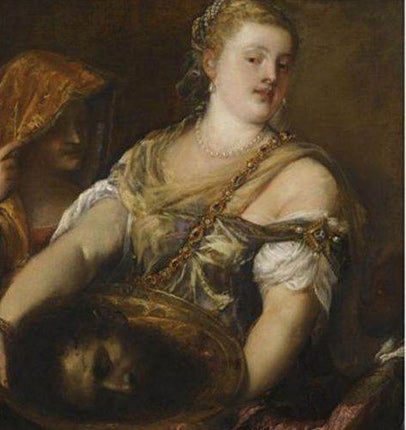Couple settle after their 'Titian' was sold for a song
Dispute with Christie's after painting worth millions was bought for £8,

When Salome was told by her father-in-law Herod Antipas that she could have anything she wanted she requested the head of St John the Baptist on a silver platter. His crime: daring to criticise her mother's marriage.
Similar feelings of retribution must have crossed the minds of a brother and sister after parting company with their painting of the seductively gory Biblical scene for just £8,000 only to see it resurface a few years later as a genuine Titian with a price tag of between £2.3m and £3.8m.
Yesterday the siblings reached an undisclosed settlement with the auction house Christie's just before the dispute was to be heard in the High Court in London, after the judge indicated that an "agreed compromise" had been struck between the warring parties.
The dispute settled on whether or not the 16th century oil, entitled "Salome With the Head of St John the Baptist", pictured above, in far from perfect condition, was actually from the hand of the world's most bankable artist or the product of his workshop of apprentices.
David Seton Pollok-Morris Dickson, from Symington, Ayrshire, and Susan Marjorie Glencorse Priestley, from Clapham, south-west London, claimed they had missed out on the true value of the work when it was sold by the auctioneers in 1994. They claimed London-based Christie's was guilty of a "breach of duty and/or negligence" alleging that had they been advised that restoration and cleaning work on the Old Master could have led to verification that it was an original, they would have commissioned art experts to do so.
It emerged in court papers that Mr Dickson was only alerted to the true provenance of the piece when he saw it in 2004 at the Age of Titian exhibition at the Scottish National Galleries.
In the decade after its sale the painting had found its way into the private collection of Luigi Koelliker in Milan where it was cleaned and eventually deemed to be an original having once formed part of Charles I's personal gallery and even featured the monarch's monogram on the back.
It was offered for sale by Sotheby's in New York in 2009 with the multi-million reserve although it failed to attract a bid. The picture was first "rediscovered" by Aidan Weston-Lewis, chief curator of the National Galleries of Scotland. But yesterday he said there was still room for doubt. He said: "We do not know for sure that the painting is by Titian. Many paintings from Titian's later career are essentially collaborations between Titian and members of his studio, with varying degrees of direct involvement on the part of the master himself. These are often difficult and subjective judgements.
"Freed from its disfiguring dirty varnish and overpaint, the painting appeared to us to include a substantial amount of Titian's own work, and this seemed to be corroborated by evidence of quite significant changes to the composition revealed by X-radiography – it being more likely that the master rather than an assistant would have been responsible for these changes."
Not faking it: Missed masterpieces
* A painting thought to be a fake for half a century turned out to be an early Van Gogh. Originally dismissed – along with a number of others – in the 1940s, Houses Near The Hague was discovered to be genuine and put on display in a small museum in Breda in the Netherlands in 2003. It bears the familiar Vincent signature. but its authenticity was questioned by the The Van Gogh museum in Amsterdam.
The work, thought have been completed in 1882, was painted on canvas and later glued to a panel.
* When a copy of a Dutch Golden Age painting by the arch-counterfeiter Hans van Meegeren was given to the Courtauld Institute of Art in 1960, the gallery's director accepted it as a fake. But, around 50 years later, The Procuress was unmasked as a genuine 17th-century 'Dutch Golden period' piece, which may have hung in the house of the Dutch master Johannes Vermeer.
* Last year a man walked into a Liverpool car wash and handed over a £10 note as payment. He turned on his heel and left with the mysterious phrase: "Keep the change – it's worth a lot more than ten pounds!" When the manager inspected it more closely, he saw that the note did not bear the Queen's head, but that of Princess Diana and was signed "Banksy of England". It is believed to be one of the famous "Banksy Tenners", pictured, and that the mysterious, generous customer was Banksy himself.
Subscribe to Independent Premium to bookmark this article
Want to bookmark your favourite articles and stories to read or reference later? Start your Independent Premium subscription today.

Join our commenting forum
Join thought-provoking conversations, follow other Independent readers and see their replies